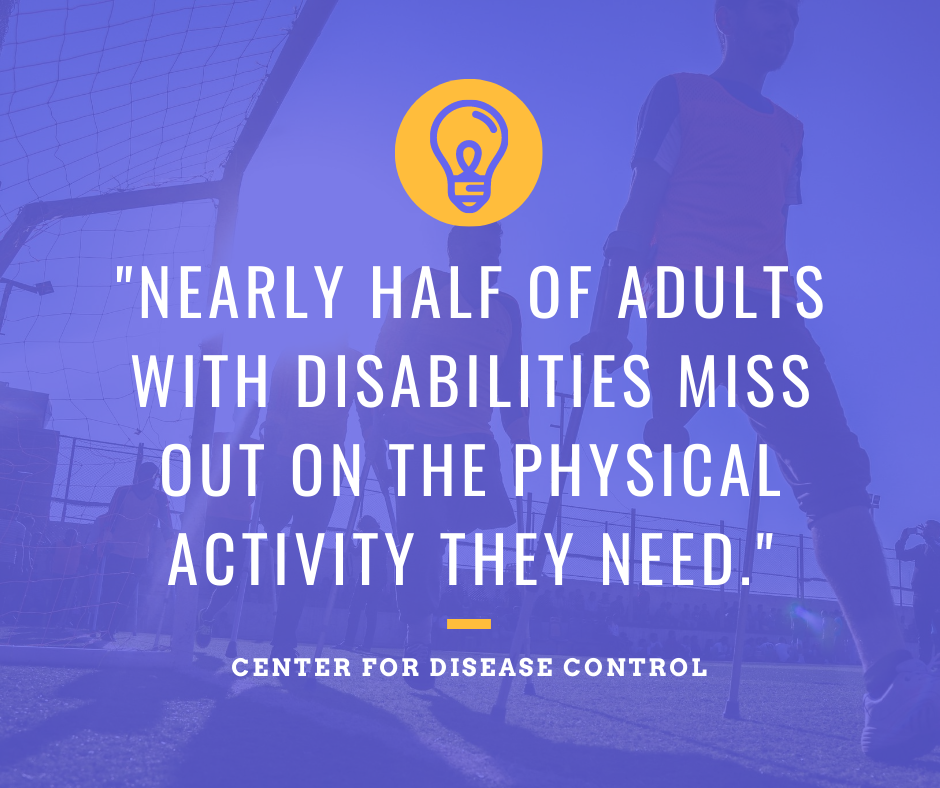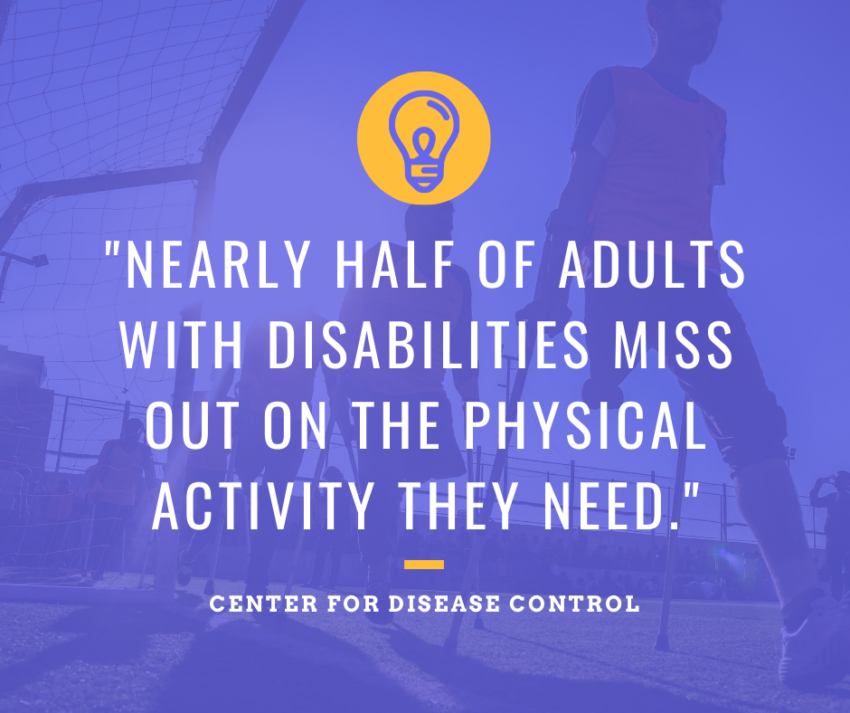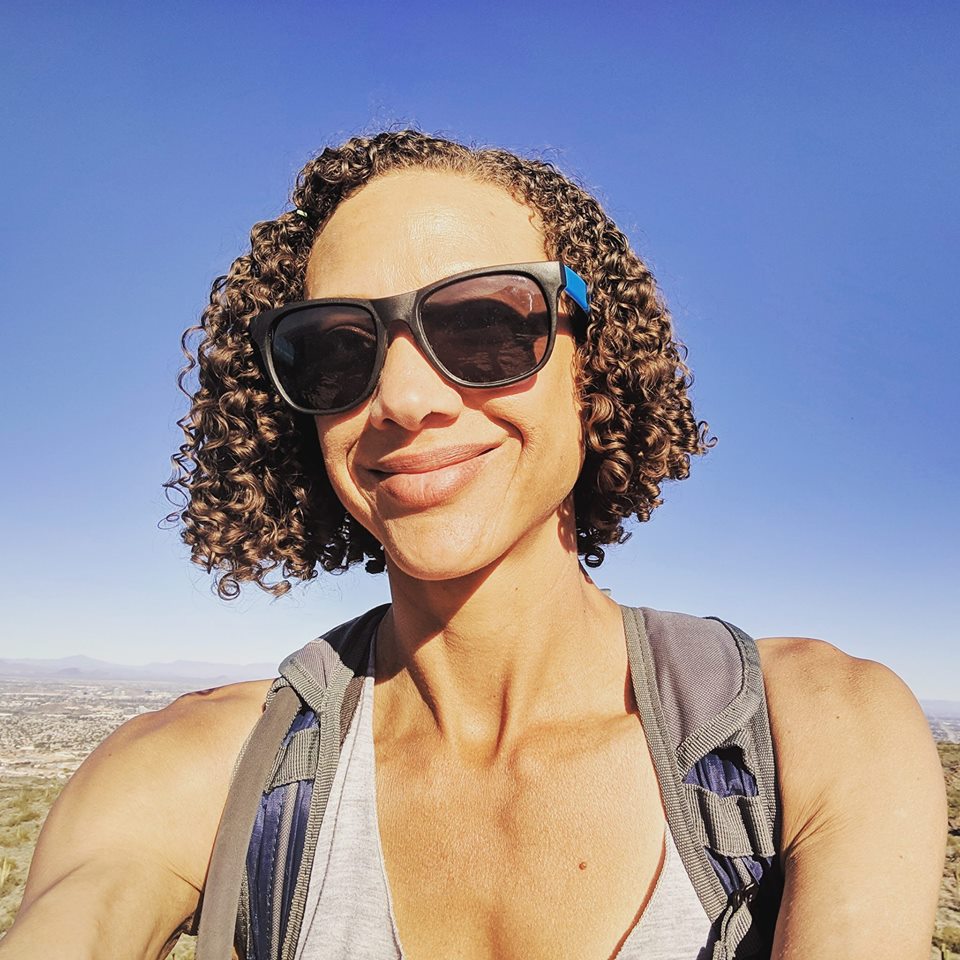
Physical activity is good for every body, including nearly 21 million Americans with intellectual and developmental disabilities. Yet the Center for Disease Control and Prevention estimates that nearly half of all adults with disabilities miss out on the physical activity they need. Exercising and being physically active involves some inherent risk for everyone but for most bodies the benefits of regular exercise far outweigh the managed risk.
Aerobic activity helps reduce the impact of heart disease, stroke, diabetes, and cancer; all of which adults with disabilities are three times more likely to experience. Resistance exercises increase bone density and muscular strength, while successfully meeting a physical challenge yields a multitude of mental and emotional benefits for everyone. So how much physical activity do adults with disabilities need to experience these benefits?
Physical Activity Recommendations
Recommendations for adults with disabilities are the same as for other adults: 150 minutes a week of moderate-intensity aerobic activity and activity involving all major muscle groups on 2 or more days a week. There are a variety of ways to meet these recommendations but when it is not possible, a focus on simply avoiding inactivity can be extremely beneficial and allow you to continue progressing toward your goals.
There is a key guideline for adults with disabilities; activity should be performed according to their physical abilities. This simply means exercise or activity should be safe for the individual to attempt and designed with their specific capabilities in mind. Most bodies have some movement patterns or exercises that may not be performed without pain, discomfort, or further damage. These are contraindications or factors that serve as a reason to avoid performing an activity due to the harm that it would cause.
An experienced fitness professional is able to design activities or exercise that exclude contraindications for most any body. In my 10 years of helping people meet their fitness goals I have only ever encountered three individuals who didn’t require a modification to an exercise due to an injury, health issue, or congenital challenge. Conversely, I’ve seen countless bodies with a wide variety of abilities thrive when they become more physically active.
Guidelines for Becoming More Active
My best advice for becoming more active is also the same for adults with disabilities as for other adults.
- Check in with your physician. Ask if you’re able to participate in regular physical activity or increase your activity level. Ask for your physician’s recommendations on types of exercises to perform and avoid.
- Start small. Little steps toward our goals are far more likely than giant leaps to become part of our daily routine. Your 150 minutes of moderate-intensity aerobic activity per week can be accomplished in bouts as short as 10 minutes. Check out these 15 minute fitness videos I created for Tempe Parks and Rec. They will prove there’s staying power in small steps forward.
- Create positive experiences. In the beginning it’s most important that you want to come back for more. You can challenge your limits after some hard work; once your endurance and confidence have been developed.
- Make a plan. Identify a healthy activity you’d like to adopt as a habit. Then create a simple but SMART goal based on that activity. Example: I am going to walk 2 miles every weekday morning for the next three weeks. Then follow through and track your progress.
- Work with a professional. Not only can a fitness professional create appropriate challenges based on your individual capabilities, they are experts are safely pushing you to exceed what you thought you could do.
- Choose a fitness professional who can confidently communicate with physicians or physical therapists and design routines incorporating their recommendations.
- Ensure your fitness professional understands and practices people first language as well as the teach back method.
- Bonus: Individuals with disabilities who participate in Arizona’s AHCCCS program can work on habilitation skills (like mobility training and sensory-motor development) with Fitness Professionals who are also certified as a Direct Care Workers at no cost to them. For more information contact me or check with your direct care staffing agency.
OK; now you have my best advice for getting active – in any body. Let’s make healthy choices for ourselves and those we care for. If you’re feeling inspired, I’d love to know your plans to change the physical activity in your life, or the life of someone you care for.
Sources
Increasing Physical Activity among Adults with Disabilities. (2020, April 23). Retrieved August 17, 2020, from https://www.cdc.gov/ncbddd/disabilityandhealth/pa.html
Secretary, H., & President’s Council on Sports, F. (2019, February 01). Physical Activity Guidelines for Americans. Retrieved August 18, 2020, from https://www.hhs.gov/fitness/be-active/physical-activity-guidelines-for-americans/index.html

